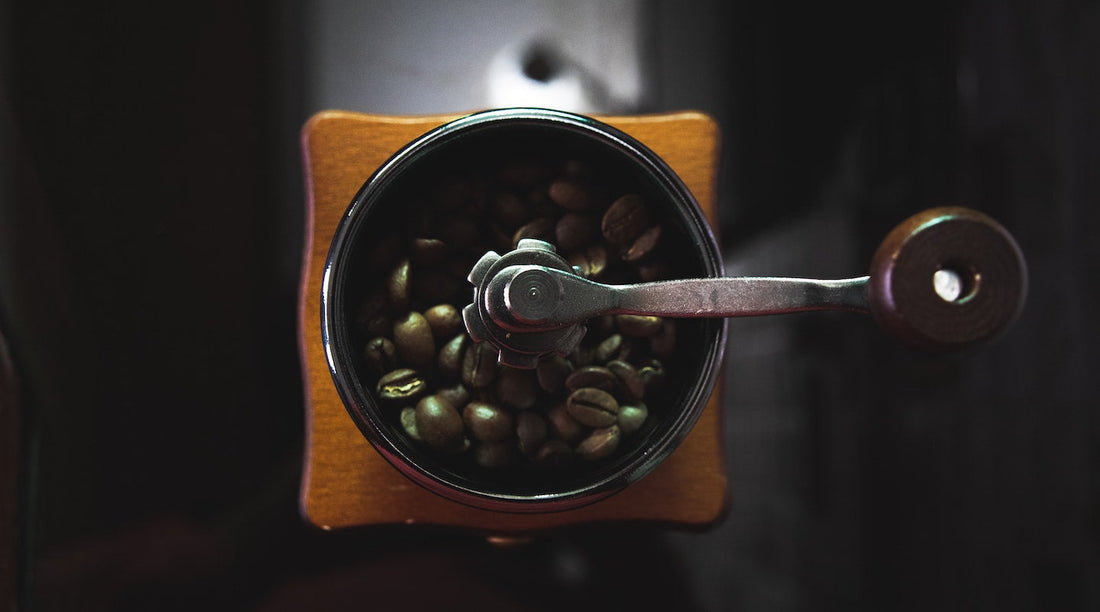
How to Grind Coffee Beans
Coffee TalkFor most of us, sipping on a perfect cup of coffee in the comfort of our own home has become a ritual for us—our daily dose of Zen before we dive into the day. Grinding whole bean coffee is the best way to get the freshest cup and flavor notes—grinding matters. From the moment we smell those beans to the sound of the drip brewer, French press or single-serve coffee maker—we just can’t live without our coffee. Coffee is a staple in our lives and holds us together when times get tough.
In fact, according to 2022 NCA National Coffee Data Trends, 84% of coffee drinkers prefer making coffee at home. Home brewing provides easy access, along with the freedom to experiment and get creative with your favorite caffeinated beverage. (That place around the corner can’t offer that!)
We get it. Buying pre-ground coffee saves time, effort and energy—especially if you’re impatient, undercaffeinated and always in a rush. But the truth is—not only does grinding your own beans add to the coffee-drinking experience in general, but understanding the importance of grind size will make a huge difference in the flavor and textures of your cup of joe.

[Photo credit: Zarak Khan via Unsplash]
Everything You Need to Know About Grinding Your Coffee Beans
1. The Benefits of Freshly Ground Whole Bean Coffee
It’s always best to buy whole bean coffee and grind those beans at home. Whole bean, in general, stays fresher than ground coffee when stored properly. Roasted beans can keep for about two weeks at room temperature because they contain carbon dioxide, the gas that prevents the beans from going bad and tasting stale.
Grinding whole bean coffee right before you brew it is another way to create a perfectly fresh and flavorful cup of coffee every time. That’s because flavor is lost the longer ground coffee is exposed to the air. When beans are ground ahead of time, the important oils in the coffee react with oxygen and quickly begin to evaporate. Even the freshly ground coffee starts to lose some flavor 15 minutes after you grind the beans. Grinding the beans at home will allow you to move at the speed of light between grinding and brewing—and then enjoying that cup.
2. Why Does Grind Size Matter?
No matter how you brew it, your goal is the same. Get flavor and caffeine from the coffee grounds, a process called extraction. To do that right, you have to pay attention to the grind size. Some specific grinds you need for certain coffee types can be hard to find at the store. You may also be limited in your favorite blend or flavor of coffee too.
When you’re grinding the beans at home, it might take you a little longer and you’ll have to invest in a grinder, but then you’ll enjoy the freedom to grind any size—from espresso to French press.
3. Types of Coffee Grinds
Ok, we know why grinding beans at home is important. But having the beans is one thing—and knowing what to do with them is another.
If you are going to grind coffee beans like a pro, you also have to understand all of your options like different sizes, textures and brewing methods. One of the most common mistakes in brewing a perfect cup of coffee is getting the right grind for your brewing method. If you grind your beans the wrong way, that will definitely affect the overall flavor profile and texture of the brew.
Grinding beans the right way ensures that the water runs through (when using a Chemex) or steeps with the ground beans (when using a French press). The smaller the coffee particles, the less time is needed to get the most flavor out of the beans. So, the overall cup relies on whether the grind is coarse or extra fine.

[Photo credit: Gabriel Meinert via Unsplash]
7 TYPES OF COFFEE GRINDS:
- Extra Coarse Grind: Extra coarse grinds have a rough texture and are only slightly ground. The shape of the original beans is still intact and typically best when used for cold brewing methods or cowboy coffee.
- Coarse Grind: Coarse grinds are large, even chunks, similar to Kosher or sea salt. These grinds are most commonly used for French press coffee and cupping.
- Medium-Coarse Grind: Medium-coarse grinds feel like rough sand. This grind falls somewhere in the middle of medium and coarse grind levels and are used in specialty brewers such as the Chemex.
- Medium Grind: Medium grind is the most common grind size when you buy pre-ground beans. Medium grinds are still like sand but have a smoother texture (compared to the medium-coarse grind). This grind is best when used with drip brewing methods, pour over and Chemex.
- Medium-Fine Grind: Medium-fine grinds have a texture that is just a touch smoother than sand and are used for pour over, Moka pot and the Aeropress.
- Fine Grind: Fine grinds are very, very smooth—almost like powder. That's why this type of grind is best used for espresso.
- Extra-Fine Grind: Extra-fine grinds have a powder or flour texture. They are best used for Turkish Coffee.
4. Types of Brewing Methods
Ok, now that we’ve identified the grind sizes, let’s connect them with your favorite brewing method. (Watch out, baristas—here we come!)
- Cold brewing coffee: Because there’s no heat to give the brewing process an umph, cold brewing can take up to 8 hours. Since cold brew needs so long to steep, use extra coarse grinds for a tasty, cold and caffeinated treat.
- Immersion brewing: During immersion brewing, ground coffee comes in contact with water for a long amount of time, so grind a coarse or medium-coarse grind for the most flavor in your cup. Immersion brewing methods include French press and Chemex.
- Electric brewing: Electric brewing is the most popular brew method in the U.S. and includes automatic drip and single-serve brewing. To get the perfect cup, you’ll want to use a medium grind.
- Manual brewing: Manual brewing is a brewing style poured by hand over the ground coffee. It includes pour over, Chemex and any other cone-filtered method. The advantage of manual brewing is the flexibility you have to experiment and make your coffee exactly as you want it. You have full control of the water flow, which means you have full control of the brewing experience. Try a medium-coarse, medium or medium-fine grind to see what you like best.
- Pressure extraction: Pressure extraction includes espresso brewing. This brewing method forces hot water through tightly packed and finely ground coffee. Reach for a medium-fine or fine grind for the best flavor.
- Turkish coffee: Turkish coffee requires a combination of extra-fine grinds with sugar, water and spices boiling in a small pot. The extra-fine grind is key because there’s no filter involved in this process.

[Photo credit: Sina Asgari via Unsplash]
5. At-Home Machines for Grinding Beans
You’re close to being a pro at this grinding business, but first, you have to choose the right type of grinder for your home—and your coffee preferences. You can choose from four main types of grinders to allow for experimentation to see what works for you.
- Blade grinders: You’ll find this type of grinder the most in homes because it’s the most affordable. Blade grinders have a blade at the bottom of the grinder and offer a few speed settings, similar to a little food processor. These grinders work best for coarse-to-medium grinds—but beware: The limited speed settings might make the result a bit inconsistent for you. Some of the grinds might end up too fine and even powdery, which might create an unbalanced cup.
- Burr grinders: This type of grinder is really the preferred grinder if you know a thing or two about coffee and what you like. Burr grinders have a multi-blade system so coffee beans can be crushed, allowing for a more consistent grind.
- Conical burr grinders: Conical burr grinders are for the pros! They are the grinders you see at your local cafes. The cone shape and multiple settings to choose from provide so much accuracy and deliver the best grind sizes and textures.
- Hand grinders: These grinders will allow you to make specialty coffee right at home—even during a power outage when you have to reach for those candles. Hand grinders were once the most common at-home grinder, but the ease of blade grinders took over that slot in more recent years.
6. How to Grind Coffee Beans at Home Without a Grinder
Buying an at-home grinder may not be in the budget for you quite yet, so we thought we’d offer some creative ideas for how to make coffee at home without purchasing a grinder—but with equipment you already have in those cupboards and drawers of yours.
Remember, you can always order directly from Death Wish Coffee—or better yet, get fresh coffee delivered to your door on-demand with a coffee subscription. Choose from a variety of blends and select your favorite grind. Nothing beats ground coffee delivered right to your door. Always organic and Fair Trade Certified guaranteed, we grind it, seal it immediately, and it heads right to you—full of flavor and bursting with aroma.
- Use a blender: A blender will allow you to experiment with coarse and medium grinds right at home. With its simple blades and low-speed setting, shove the protein shake aside for later and grind up some coffee beans instead.
- Use a mortar and pestle: Welcome back to the Stone Ages, people! These two tools will help you grind and crush those beans to a consistent medium-fine to fine grind. You’ll have to put some muscle into it, but everything worth having takes effort—coffee is no different.
- Use a food processor: The food processor will also help you reach your desired grind texture. You may want to target only 1/2 cup of beans at a time for the most consistent results.
- If all else fails, grab a rolling pin, meat tenderizer or a kitchen knife—anything that will help you can chop, crush or grind. It’s all about experimenting when trying to achieve that perfect cup!
The truest grind you will find is the one that is most favorable to your own taste buds. Experimenting is the best way to find the right one for you—and half the fun of creating that perfect cup. The smallest change in grind can result in a noticeable outcome. Now grind it out!
[Featured Image Credit: Dinker Gulati via Unsplash]
